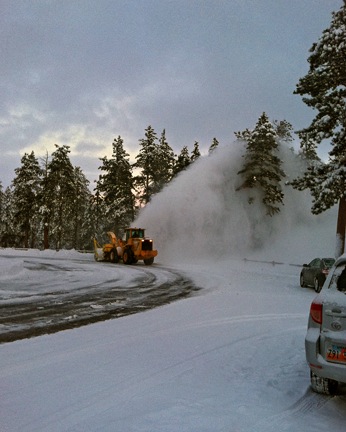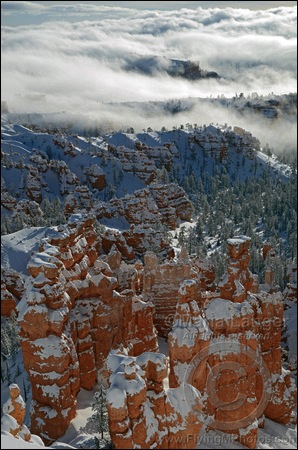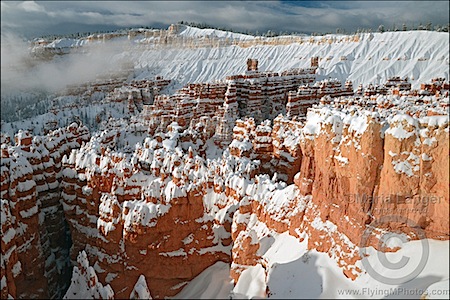It’s all about timing.
I’m at Bryce Canyon with one of my aerial photography clients this weekend. Although we’re here to do some aerial work at Bryce and then at the Grand Canyon (and maybe Sedona), we’re grounded due to weather. Yesterday dumped at least 10 inches of snow in the area, blanketing everything with thick white snow. Last night, it started to clear out. My client and I arranged to meet before dawn and see what we could shoot in the park at sunrise.
We met at 6:30 AM. The moon, waning two days past full, was still up and, at one point, was beautifully framed by the tall, snow-covered pines along the park’s entrance road. We pulled over into a cleared area and my client spent about 20 minutes standing in the snow across the road with his tripod and camera. I took the opportunity to touch base with my husband back in Wickenburg.
The clouds were moving in again when we finally got back on the road. My client didn’t have much hope. I was uncertain. I know how quickly conditions can change up here. I also knew that the temperature/dew point spread at the airport 5 miles away was only 2°C — and that meant possible fog. I was hoping some of that fog might be in the canyon.
Inside the park, only two viewpoints were open: Sunrise Point and Sunset Point. Both look out into the “Amphitheater” area , a roughly C shaped canyon facing southeast. My client and I were glad the other road was closed; it meant our brief aerial photo work the next morning was less likely to bother park visitors.
 My client steered us to Sunset Point. Two very large snow throwers were at work in the parking area where only two cars were parked. We parked behind one of them, got our gear together, and headed out to the lookout point.
My client steered us to Sunset Point. Two very large snow throwers were at work in the parking area where only two cars were parked. We parked behind one of them, got our gear together, and headed out to the lookout point.
Although the path had been cleared the day before, about 2 inches of fresh powdery snow lay atop the surface. Below that was a sheet of ice. We both walked carefully. The viewpoint was deserted. The view was…well, interesting, but not perfect. The fog I wanted to see was layered in the canyon and at various other places beyond it. There was enough fog to make it interesting without really obscuring the hoodoos — red, column-like rock formations — that we’d come to see. The trouble was, the light was awful. The sun was up, but it was hidden behind thick clouds. The light was gray and lifeless.
The hiking trail down into the canyon was open — despite thick snow covering the pathway. My client, who was prepared to hike in deep snow, announced he was going down. I had the car keys. The idea was that when I got cold, I’d wait for him in the car. My iPad was in there, so I’d be able to read or check e-mail. He headed down and I walked back to the view point to see how things would change.
Another photographer showed up about five minutes later. We got to talking. He was from the Salt Lake City area and had come down the day before. He couldn’t believe all the snow he was seeing had fallen in just that day. As we chatted, we snapped photos. I had my monopod with me; he was shooting handheld. (My client was lugging a very heavy tripod down the trail with him.) A few minutes later, the man’s family joined us. He and his daughter (I assume) headed down the trail, leaving me up top with his wife and other daughter (I assume). We did a lot of chatting and photo snapping as time went on.
 The first hint that things might improve came a while later when the sun started breaking through the clouds. I snapped this photo using the HDR function of my iPhone and then fixed it up a bit more in Photoshop to bring out the shadows. Not too impressive. The light faded again right after that and I started thinking about how warm the car might be. But I decided to stick it out a bit longer.
The first hint that things might improve came a while later when the sun started breaking through the clouds. I snapped this photo using the HDR function of my iPhone and then fixed it up a bit more in Photoshop to bring out the shadows. Not too impressive. The light faded again right after that and I started thinking about how warm the car might be. But I decided to stick it out a bit longer.
I was glad I did. A few things happened:
- The sun rose higher. Of course, I expected that.
- The clouds drifted on a gentle breeze to the west. The effect of that was to make it easier for the sun to poke over the top of the cloud bank.
- The fog bank began drifting into the canyon.
The effect of all these changes, which occurred over the course of about an hour, was to make an amazing, constantly changing scene in front of me. I began doing real photography. The three photos shown below are among the best I shot.
 Snowy Bryce Dawn 1
Snowy Bryce Dawn 1
D7000, f/10 @ 34 mm, 1/400, ISO 400, No Flash
What I like most about this first shot is the laying of the low clouds among the hoodoos in the canyon. This really helped to separate the rock formations and add an element of three-dimensionality. It was also neat to be above the clouds without having to fly there.
I had two lenses with me: a Nikkor 10-24mm and a Nikkor 16-85mm. Although I prefer the 16-85mm lens — it’s the absolute perfect all-purpose lens — I found that I was shooting most photos with the wider view. With my Nikon D7000’s 1.5x crop factor, this lens, at its widest focal length, is equivalent to a 15mm 35mm camera lens. There’s very little distortion — unlike my 10.5mm fisheye, which is fun but not practical. I liked the way it accentuated the sky in some of the earlier shots I took.
For a while, I switched back and forth — no easy feat when wearing gloves and relying on a jacket pocket for lens storage. Later, as the light continued to change, I wound up sticking with the 16-85mm lens, which also had a polarizer on it. That came in handy when the sun had risen high enough over the cloud bank to bring out some of the colors. I’m a big fan of using polarizing filters when the light is right for them. It really can accentuate the outlines of clouds and the blue of the sky, not to mention the red in the rocks.
 Snowy Bryce Dawn 2
Snowy Bryce Dawn 2
D7000, f/10 @ 16 mm, 1/400, ISO 400, No Flash
I’m actually a little annoyed about this photo. When I shoot, I compose in the camera with every intention of using the full frame image. In other words, I shoot photos that don’t need to be cropped. This is very easy if you use zoom lenses, which I do, and take the time to compose properly.
The problem with this image is that when I shot it, I included my monopod head, which was leaning against a fence rail, in the lower-left corner of the picture. It ruined the photo. The only way to “fix” it was to crop it. This was the best I could do. It is not as I intended. I may attempt to remove the monopod head with Photoshop in the future, but I generally don’t like doing things like that. We’ll see.
 Bryce Canyon Lone Pine
Bryce Canyon Lone Pine
D7000, f/11 @ 24 mm, 1/500, ISO 400, No Flash
I like to shoot foreground items with interesting backgrounds. This tree, with the fog, clouds, and sky behind it to separate it from the background details, made a great foreground subject. And what could be more interesting in the background than snow-covered red rock hoodoos?
In all, I shot about 50 images over the course of 90 minutes. These were the three I liked most after viewing them on my laptop. I might find other favorites when I get back to my office and have time to look at them again.
I should mention that my camera was outfitted with its Nikon GPS, which worked like a charm to encode location information into each shot. This was the first time I used it. The device is awkward and I’m not sure how often I’ll really want to use it. I might reserve it for tripod-based work.
The fog bank continued to move in and eventually blocked out the sun again. The overlook chilled back down to its pre-sun temperature. Down below, on the trail, my client and the two other people who’d gone down started back up. The dad and his daughter arrived first and the family left together. When I realized my client had stopped for more photos, I decided to head back to the car. He joined me about 20 minutes later.
It had been a nice morning shoot, despite the cold. My client says there’s too much snow on the hoodoos for the aerial shoot we need to do before heading south again. While I agree that there’s a lot, I don’t think there’s too much. The red rocks are still clearly visible and should look great from the air.
As I write this four hours after our return, the snow is falling again. Let’s hope it doesn’t add much more to the scenery here.
Discover more from An Eclectic Mind
Subscribe to get the latest posts sent to your email.

Great photos
@Jason: Thanks!
Maria-
You certainly have an eye! your photos are breath-taking! You should come one Monday to the Wickenburg Camera Club meeting. They would be so appreciative. I know that all sounds rather hokey, but there are some very talented photographers in it.
I fly over Monument Valley, Lake Powell (near Navajo Mountain), Bryce Canyon, Zion, and Yosemite all the time and should show you some of my photos sometime. I love flying around Mt.. Rainier and Adams as ATC allows us to fly at whatever altitude we want and as close as we want.
Keep up the incredible work. I hope you had fun in the Bahamas.
Jim
@Jim: Thanks. I’m really not around Wickenburg much these days, so it’s hard to schedule anything in town.